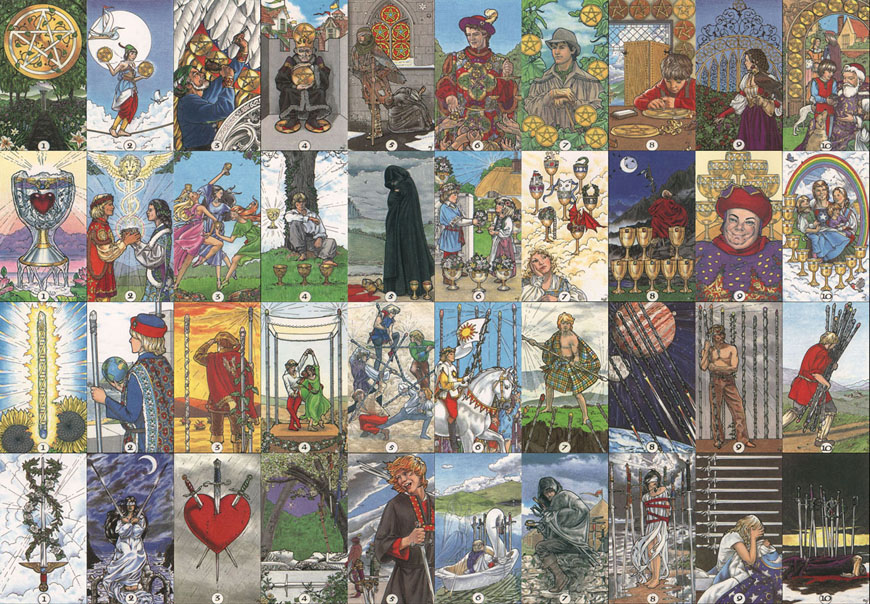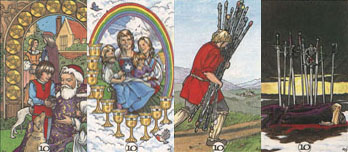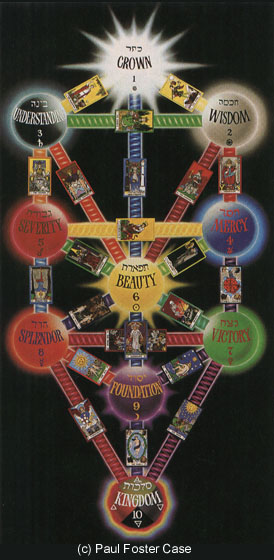Brian's Tarot Page |
The purpose of this page is to briefly discuss the some aspects of Tarot, primarily the Minor Arcana. A lot of attention is paid to the Major Arcana (the Trump cards, 0-21), but less so is paid to the Minors. There are even some decks that don't show pictures for the Minor Arcana.
What I will attempt to do here is to not give descriptions for each of the Minors, but to instead show the relationships that one card will have with the cards around it, and how the progression through each suit can, in fact, tell a story.
There are some decks that do, in fact, tell stories for each of the suits. My favorite of these is the Art Nouveau, and each Minor Arcana is almost like looking at a frame in a comic strip, the stories are so cohesive. The Mythic Tarot is another such "story line" type deck, and it uses actual Grecian myths for each of the suits.
Here, however, we'll look at a more standard deck ("standard decks" being the Rider-Waite-Smith and its derivatives), in this specific case the Robin Wood Tarot. The Robin Wood is, with very view exceptions, symbolically identical to the RWS, but the art is prettier (all due respect, of course, to Ms. Smith.)
Below is the entire Minor Arcana of the Robin Wood deck*.
The first step, before any serious study of the Tarot can be made, is to mediate on the cards. If you own a Tarot deck, lay the Minor Arcana out, as below, or use the graphic below. Take a few minutes to look over the cards below, paying attention to any progressions you might see, or any similarities between cards of one suit and another. Also look at any general trends within the suits themselves. [Bring graphic to top of page]
 [down]
[down]
* - For purposes of this page, "Minor Arcana" does not include the Court Cards (Page, Knight, Queen and King). Even though they are technically part of the Minor Arcana, they don't fit the "story line" model, so are not part of this discussion.
|
It is important to recognize that each suit has an elemental correspondence. The Aces show the elements quite nicely in this deck: Pentacles are Earth (physical, material, stability, hands and feet), Cups are Water (emotions, intuition, heart), Wands are Fire (passion, energy, action, the groin), Swords are Air (intellect, intelligence, the mind). Thus, all Cups are, somehow, involved with emotions and Water energy. Note: some decks (and magical belief systems) attribute Swords with Fire and Wands with Air. While arguments for both sides have validity, for purposes of this discussion we will use the correspondences found in the "standard" Tarot deck. It is also important to note that each number has a correspondence. These correspondences have basis in the Kabalah, which is an ancient system of Jewish mysticism. In the Kabalah, and specifically the Tree of Life glyph (see left), the Divine has 10 Sephiroth ("emanations"), each representing an aspect of the Divine, and also a stage of Creation. 1's are the closest to the "pure" Divine, and the farthest from the physical realm of Creation, while 10's are the physically manifest. In my opinion, any study of Tarot cannot ignore the Tree of Life; however, since Kabalah is a vast subject, it will only be briefly referenced here as it is needed. As an aside, the Major Arcana correspond to the paths between the Sephiroth, as shown in the diagram. The Major Arcana, then, represent the process of movement or change from one state of Creation to another. Let us first look at the numbers themselves, and the progression from 1 to 10. [Bring table to top of page] |
ACESThis is the influx of new energy. In the Tree of Life, this is Kether, "The Crown", and represents the Divine in a "pure" form. Kether is without gender, and without form. In the Tarot, then, Aces are the "pure essence" of the suit, but as such they are nothing more than conceptual. They are the spark from which the story takes place, or Creation is started. In a reading I usually liken the Aces to an "influx of new (elemental) energy". Ace of Swords: "A new idea, a surge of mental activity, perhaps a new insight." |
 |
TWOSTwos represent balance. The One (Ace) becomes Two, and differentiation is begun (male and female, front and back, yin and yang, etc.) It is arguable that the entire push of the Tarot is towards balance. But the balance represented in the 2s is very archetypal, and, like with the Aces, is nearly without form. In Kabalah, the second Sephiroth is Chokmah ("Wisdom"), which is the primal male energy, and the top of "Pillar of Mercy", or the masculine pillar. This is pure force. Divinity (Kether) has decided to form a Creation; Chokmah is the formless force moving towards that Creation. The Two of Cups, while being a balance of the heart, and meeting of male and female, is more "mystical", more highly symbolic, than the more down to earth Four of Cups (the couple dancing beneath the wedding tent.) |
 |
THREESThe third Tree of Life Sephiroth is Binah ("Understanding"), which is the primal Mother. This is Form in it's purist. This is the highest ideal of "Form." Threes also represent the first manifestation. One has become Two has moved to Three, which is the next step towards true (earthly) manifestation. This is a completion. The foundation of the Creation is made. All further numbers build upon what the first three represent. If you will notice the Threes in reference to the later numbers, you will notice that there are similarities in concepts. Take a moment to compare the Threes with the similarly suited Tens. Also look at the Three of Pentacles and the Eight of Pentacles. [down] |
 |
After the Three, Creation (and the Tarot "story line") in some ways restarts. The foundation of the story has been laid, and now its time for the actual story to unfold. On the Tree of Life, the jump from Three to Four also represents the bridging of the "abyss", in some myths attributed to the Biblical "Fall from Eden". Some Kabalists place an "eleventh sphere" in the midst of this abyss, called "Da'ath", or "Knowledge." Again, we won't go into details here, but suffice it to say that there is a significant change from the Three to the Four. [Bring table to top of page]
FOURSAfter the initial three stages of Creation, our story line restarts. In the Three, we see what the "goal" of each element is; Fours, then, can represent the initial impulses towards that goal (or, in the case of the Four of Swords, a rest from the pain ahead). On the Tree of Life, the forth Sephiroth is Chesed, ("Mercy"). This is the sphere of compassion, and also self-righteousness. In the Tarot, Fours represent also "cohesion". The elements take the energy from the first three spheres, integrate them into a cohesive whole, from which the next stage of the journey springs from. |
 |
FIVESThe vision of the "goal" of the suits (the Ten, as seen in the Three) brings to light the possibility of failure to obtain that goal, and also the struggles involved with obtaining that goal. This is what the Fives are all about. On the Tree of Life, the fifth Sephiroth is Geburah, "Severity". This is a balance to the "Mercy" of Chesed. This is discipline and strife. To some, Geburah is also the sphere of Karma. In our Tarot "story line", Fives may be warnings regarding "unbalanced" activities within the realm of the Fours, or actual results of those actions. For instance, holding too tightly to something (Four of Pentacles) taken to an extreme, can result in a loss of that thing (Five of Pentacles). |
 |
SIXESTiphereth, the sixth Sephiroth on the Tree of Life, is called "Beauty." This represents the second sphere on the "Middle Pillar", and, as are all spheres on the Middle Pillar, is balanced between the extremes of the other two pillars. Where Five was the balancing force for Four, Six is the result of Four and Five balancing one another. In our Tarot story line, we have learned from the experiences of the Five and have added new, positive energy towards our goal. The taste of loss and failure have renewed our vigor towards the goal. Sixes are an examination of our experiences with the Five. For instance, upon experiencing emotional loss (Five of Cups), the next step is to return to our roots, to our past, to the joy of nostalgia, to renew our desire for completion (Six of Cups) [down] |
|
SEVENSTo me, Sevens represent not only the vision of the journey for that particular suit, but also what each suit has to offer the Traveler. This is also the "art" of the suit. After being in the space of balance, on sphere Six, Seven represents the return to the Pillar of Mercy. Netzach, the Seventh Sepheroth, is "Victory". It is the final preparation for the remaining legs of the journey. We've made it this far towards the goal. We've seen a prelude to our goal (Three), we've experienced loss (Five), and now we experience the strength of the suit in which we travel, and have a vision of how to obtain our goal. |
 |
EIGHTSNow that we've seen how to obtain our goal (by experiencing the vision of the Seven), it is time to move over to the Pillar of Severity, and actual do something about obtaining our goals. The Eighth Sephiroth is Hod, "Glory". This balances the "art" and internal work of Netzach with "science" and external work. Eights can be seen as journey cards; as the actual walking on the path. At this point you can see, according to the Tarot, the limitations of the suit of Swords, or unbalanced intellect. The "journey" of pure Air is a trap, wandering around within the confines of a closed mind, like air in a whirlwind (Eight of Swords). |
 |
NINESWe're almost there! The work has been done (Eights), and now is that time of potential, right before the journey is completed. This is the second to last chapter in our Tarot "story lines". Yesod, the ninth sephiroth, is "Foundation". It's primary correspondence is with the moon, or the astral plane. This is the universe before it manifests, completed but waiting on other side of the veil. This is the Big Bang before the explosion. [Down] |
|
TENS

Completion! In the Tree of Life, the tenth sephiroth is Malkuth, the "Kingdom". This is the world of Creation manifest. The computer that you're currently reading this on is an object of Malkuth. This is the final chapter, the goal of each of the suits. The story ends, with a happy (or unhappy) ending.
We have now explored the meanings of each number. Now, let us look at each suit, and tell its story. [Page Two]




